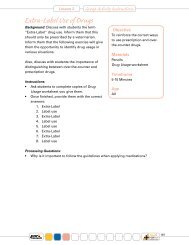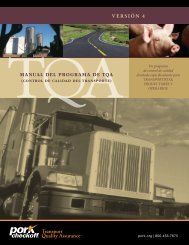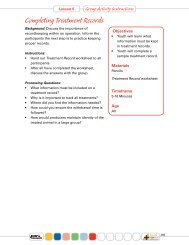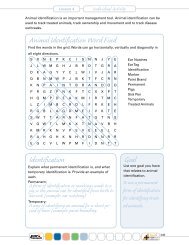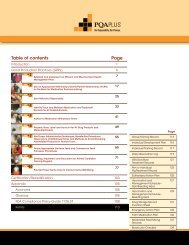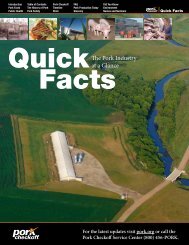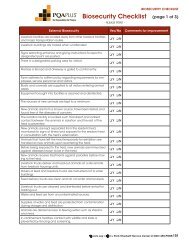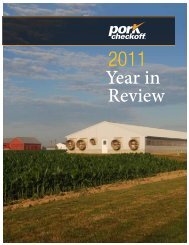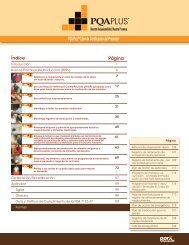Case Studies of Value Added Production and Marketing
Case Studies of Value Added Production and Marketing
Case Studies of Value Added Production and Marketing
Create successful ePaper yourself
Turn your PDF publications into a flip-book with our unique Google optimized e-Paper software.
Customer Service<br />
Cost Structures<br />
Ultimately, all three markets were built on radically superior customer service. In the case <strong>of</strong><br />
Goridto ’ s, they had developed strong relationships with Hispanic retailers partly through direct<br />
interaction, but also by assuring them they would no longer be shorted pork products.<br />
Nahunta <strong>and</strong> The Egg & I Pork Farm rely heavily on their owners’ personality <strong>and</strong> personal<br />
touch to connect with customers. This is a two way street as they learn more about what their<br />
customers want, <strong>and</strong> the customers feel like they are important to the owners. This may be a<br />
significant competitive advantage for small scale regional suppliers who help break the<br />
anonymity prevalent in commercial outlets. Clearly there are scale limitations to direct customer<br />
service which limits growth as it provides a potential niche.<br />
In addition to customer service, all three continually evaluated <strong>and</strong> responded to consumer<br />
dem<strong>and</strong>s. Goridto ’ s provides unsplit <strong>and</strong> lighter weight hog carcasses to Hispanic markets,<br />
which has allowed them to meet preferences as well as differentiate themselves from larger<br />
commercial packers. Goridto ’ s is further serving their retail customers by <strong>of</strong>fering vacuum<br />
packed primals cut to their customers’ specifications. This provides the product desired <strong>and</strong><br />
results in a cost savings to the retailers. The Egg & I Pork Farm had a great deal <strong>of</strong> interaction<br />
with customers <strong>and</strong> in addition was actually soliciting cooked pork recipes from customers to<br />
provide further custom products. Similarly, they provide custom hams <strong>and</strong> chops to restaurant<br />
customers on dem<strong>and</strong>. While this results in some merch<strong>and</strong>ising difficulties it helps build a<br />
loyal <strong>and</strong> reliable customer base. The close interaction <strong>of</strong> all associates <strong>of</strong> Nahunta with the<br />
customers <strong>and</strong> the entire production base naturally results in strong feedback directly from customers<br />
to processing. This is evidenced by Nahunta’s ability to meet dem<strong>and</strong> at any given<br />
time by altering slaughter <strong>and</strong> processing. This assures that customers will always find a reliable<br />
variety <strong>of</strong> fresh pork products.<br />
As reported by each <strong>of</strong> the firms, their costs <strong>of</strong> slaughter are remarkably consistent. Goridto ’ s<br />
reported a slaughter cost <strong>of</strong> between $20 <strong>and</strong> $25/head which was similar to Nahunta’s figure<br />
<strong>of</strong> a direct cost <strong>of</strong> approximately $20/head in a similar sized operation. The Egg & I was not<br />
yet slaughtering, but the slaughtering operation was being built partially on the premise that<br />
the $35/head charged for custom slaughter was likely too high.<br />
Nahunta provides the best illustration <strong>of</strong> processing <strong>and</strong> retailing costs although they are likely<br />
rough as well. Nahunta attributes about $20/head to processing <strong>and</strong> cooked products <strong>and</strong><br />
another $20/head to the retail packaging <strong>and</strong> cutting portion. Hence, the total per head cost is<br />
around $60/head from live to the case.<br />
Clearly, these levels are above the levels reported for commercial slaughter firms (Hayenga).<br />
However, each firm compensates for this differential by capturing the retail value <strong>of</strong> the products<br />
rather than just the wholesale level. From the cases, each emphasized the difficulty in<br />
competing at a level further removed from the customer, since these markets are typically valued<br />
via cost structure, while the consumer market represents costs plus the willingness <strong>of</strong> consumers<br />
to pay for additional value which can be differentiated.<br />
-2-





